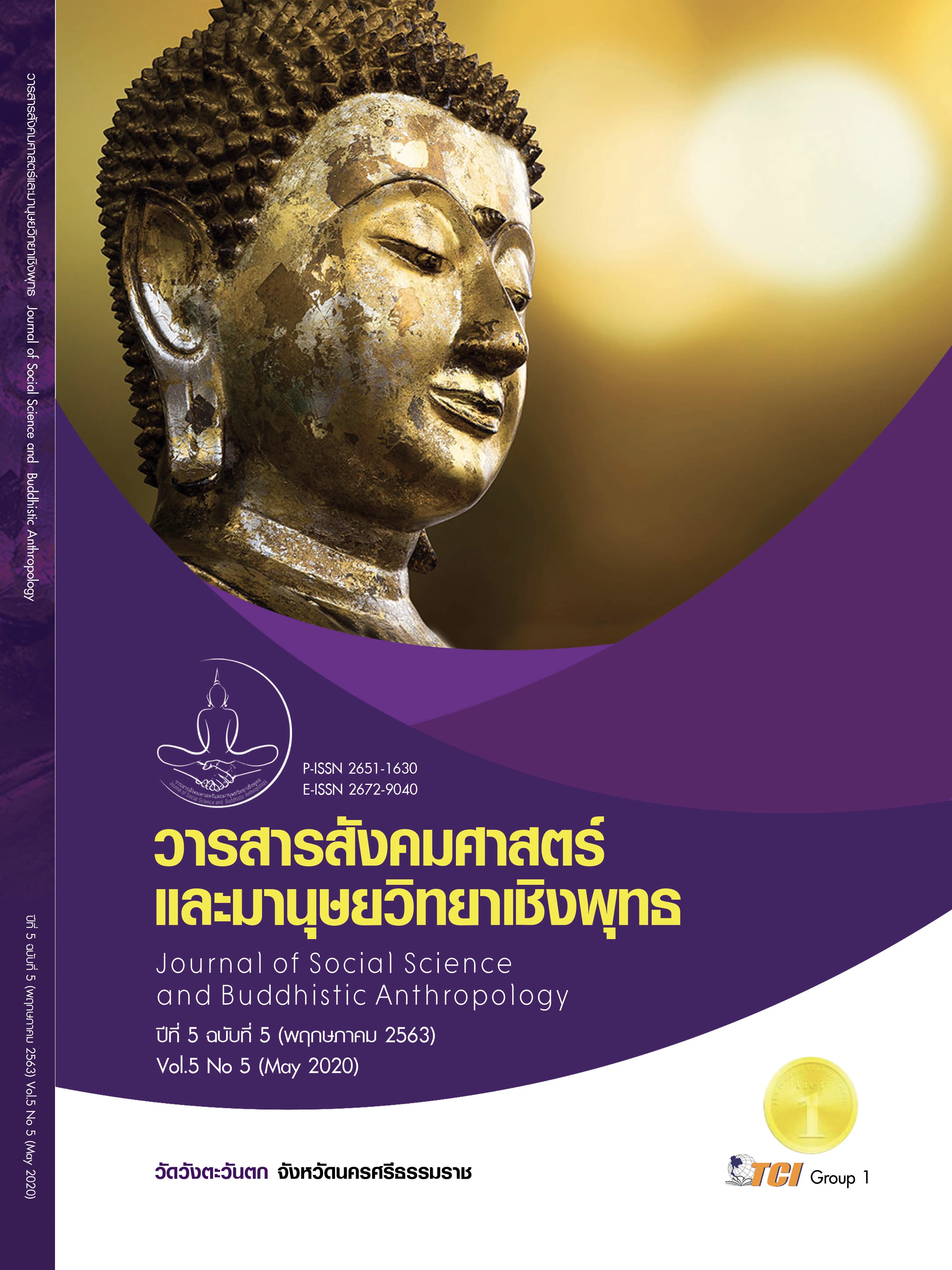THE STUDY OF KLONG SABAD CHAI’S CULTURE CASE STUDY: KHRU KAM GAWAI
Keywords:
Culture, Klong Sabat Chai, Khru Kam KawaiAbstract
The objectives of this study were: 1) to find out the origin of the new version of Klong Sabat Chai applied for today's use. 2) to find out important factors which caused changes in Klong Sabat Chai culture and 3) to find out impacts of changes of Klong Sabat Chai on its societies. The researcher applied Qualitative Research to find out these answers by analyzing from guided interviews, related documents and in - depth interview with 10 experienced people who specialized in the new-versio of Klong Sabat Chai by the method of Purposive sampling in Qualitative Research.The findings indicated that 1) there was no clear evidence identifying that Klong Sabat Chai had existed for a long time. However, it was found that this particular drums were widely popular amongst most of the temples in the Northern of Thailand the objective of which was to perform in religious ceremonies. To perform Klong Sabat Chai, the beaters hit the drum by the sole drumstick so as to prevent any body parts to touch the drum. Gong and cymbals were also used to perform. The beaters walked around slowly and performed simple gestures. This particular performing style, did not draw much of the later generations' attentions since it lacked excitement. As a result, Khru Kham Kawai created and developed the new style of Klong Sabat Chai performance by using elbows, knees and feet in the posture of crocodile slapping its tail to hit the drum and it was called the applied performance of Klong Sabat Chai. 2) Factors that led to changes into the applied version of Klong Sabat Chai performance were because of, 2.1) the Society and the Economy. The new version of Klong Sabat Chai's culture started to change when entering to the business and competition industry. 2.2) the Personal Factor (the transferrers) changed the pattern of the performance to suit the learners and the learners started to set up their own performances which led to changes in the performance patterns depending on the circumstances. And (3) the positive effects created the inheritance and the systematic learnings also helped promote original Klong Sabat Chai communities. In terms of the negative effect, there was only the conceptual conflict with those who disapproved of the applied performance of Klong Sabat Chai.
References
ดวงพร คงพิกุล. (2555). การผลิตซ้ำทุนทางวัฒนธรรม: กรณีศึกษา โรงเรียนพระหฤทัยคอนแวนต์ . ใน วิทยานิพนธ์วิทยาศาสตรมหาบัณฑิต สาขาเทคโนโลยีการบริหาร. สถาบันบัณฑิตบริหารศาสตร์.
ธิตินัดดา มณีวรรณ์. (2550). ศิลปะการแสดงพื้นบ้านของกลุ่มชาติพันธุ์ไทยยวน เล่ม 1. เชียงใหม่: มิ่งเมือง.
นันทสิทธิ์ กิตติวรากูล. (2551). กลองสะบัดชัย: เสียงกลองทีเปลี่ยนแปลงกับเวลาที่เปลี่ยนไป. วารสารการสื่อสารมวลชน, 1(1), 90-91.
บุญชุม วงค์คำอ้าย. (7 มกราคม 2563). การแสดงกลองสะบัดชัยแบบประยุกต์ที่เปลี่ยนแปลงไปจากเดิม. (เนตรนภิส พัฒนเจริญ, ผู้สัมภาษณ์)
พรรณปพร หน่อตุ่น. (2562 กันยายน 2562). การสอนกลองสะบัดชัยแบบประยุกต์. (เนตรนภิส พัฒนเจริญ, ผู้สัมภาษณ์)
พรสวรรค์ จันทะวงศ์. (2558). กลองบูชาในสังคมและวัฒนธรรมของชาวเชียงใหม่. วารสารวิจัยราชภัฏเชียงใหม่, 15(2), 18-28.
พระนคร ปญฺญาวชิโร (ปรังฤทธิ์). (2555). กลองสะบัดชัย: ศิลปะการแสดงล้านนา. (พิมพ์ ครั้งแรก). เชียงใหม่: แม็กซ์พริ้นติ้ง (มรดกล้านนา).
ไพรินทร์ กาไวย์. (12 ตุลาคม 2562). การเปลี่ยนแปลงของวัฒนธรรมกลองสะบัดชัยแบบประยุกต์. (เนตรนภิส พัฒนเจริญ, ผู้สัมภาษณ์)
ลัทธวัฒน์ สอนศรีนุสรณ์. (2552). การจัดการความรู้ภูมิปัญญาพื้นบ้านล้านนาเรื่องกลอง สะบัดชัย. ใน วิทยานิพนธ์ศิลปศาสตรมหาบัณฑิต สาขาสารสนเทศศึกษา. มหาวิทยาลัยเชียงใหม่.
ศิราณี จุโฑปะมา และศุภมาศ ศรีวงศ์พุก. (2550). ผลกระทบการเปลี่ยนแปลงของสังคมไทยที่มีต่อประเพณีท้องถิ่นในเขตอีสานใต้. ใน รายงานการวิจัย. สำนักงานคณะกรรมการวัฒนธรรมแห่งชาติ.
สนั่น ธรรมธิ. (2542). กลองสะบัดชัย. ใน สารานุกรมวัฒนธรรมไทยภาคเหนือ (เล่ม 1 หน้า 81). มูลนิธิสารานุกรมวัฒนธรรมไทย.
สมชัย ใจดี และยรรยง ศรีวิริยาภรณ์. (2545). ประเพณีและวัฒนธรรมไทย. กรุงเทพมหานคร: ไทยวัฒนาพานิช.
สมภพ เพ็ญจันทร์. (27 กันยายน 2562). แบบแผนในการเรียนการสอนนาฏศิลป์พื้นบ้าน. (เนตรนภิส พัฒนเจริญ, ผู้สัมภาษณ์)
สุธีรา อะทะวงษา. (2560). การสืบทอดวัฒนธรรมการฟ้อนสาวไหม และแนวทางการพัฒนาให้เป็นผลิตภัณฑ์บริการการตลาดเพื่อสังคม. วารสารสมาคมนักวิจัย, 22(1), 137-149.
สุริชัย หวันแก้ว. (2540). การเปลี่ยนแปลงทางสังคมและวัฒนธรรม. (พิมพ์ครั้งที่ 6). กรุงเทพมหานคร: จุฬาลงกรณ์มหาวิทยาลัย.
อรดี อินทร์คง. (2552). กลองสะบัดชัย: จินตกรรมอัตลักษณ์ล้านนาของคนเมืองเชียงใหม่. ใน วิทยานิพนธ์สังคมวิทยาและมานุษยวิทยามหาบัณฑิต สาขามานุษยวิทยา. มหาวิทยาลัยธรรมศาสตร์.








